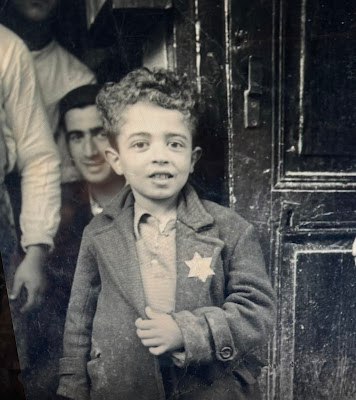Aside from one grim discovery, my trip to Auschwitz didn't teach me about the Holocaust I didn't already know. But it did convey the almost incomprehensible scale of murder in ways that the other concentration camps I have visited (Buchenwald, Terezin and Dachau) did not.
My guide, a Polish woman in her mid-thirties who always preceded "Germans" with "Nazi," noted that as late as 1944--before the Nazi Germans destroyed evidence of their wholesale slaughter and gassing--as many as 9,000 Hungarian Jews were murdered every day during a two-month period.
The Nazis also murdered 232,000 children at Auschwitz/Birkenau. They weren't all Poles, although the majority were. Italian fascists, part of the Axis powers, shipped this boy from Rhodes, an island they occupied in the Aegean Sea.
Jews from all over Europe were sent to Auschwitz via boxcars. Those that came from farthest away had no idea where they were going or what would happen to them. Many perished on the journey.
The German Nazis did the Poles a future favor when they changed the name of the small town where the murders took place. I bought a train ticket for Oświęcim and walked to the Auschwitz memorial using tiny, barely noticeable directional signs, which was quite a different experience than following the autobahn signs to Dachau, a city with the same name as the infamous camp outside Munich.
Visitors left behind their tour language stickers on a telephone pole near the entrance.
"Work will set you free."
Auschwitz was once a military barracks. Its brick buildings and orderly layout don't reveal, at first glance, their malign purpose during World War II.
Until you see the barbed wire and guard towers.
The exhibits inside leave no doubt about the atrocities committed by the Nazi Germans. Portraits of Polish prisoners line the long walls of one barracks. Auschwitz was the only camp that tattooed its inmates; inmates with tattoos liberated from other camps had been transferred.
Another barracks is filled with shoes worn by gassed Jews. Their valuable possessions were stored by Polish prisoners in warehouses they called "Canada" because friends and family members who had emigrated there described it as a land of plenty.
Primo Levi endured a pitiless "selection process" that instantly condemned the weak and vulnerable to the gas chamber.
I wasn't aware that the Nazi Germans gassed Jews in underground chambers at Birkenau, where the vast majority of murders occurred. They dropped pellets of Zyklon B (seen below at left) through holes in the roof. Death by suffocation typically took ten minutes. Imagine spending your final moments with hundreds of other writhing human beings pressed close, screaming in confused agony.
Empty cannisters of Zyklon B, developed by scientists at Auschwitz by using prisoners as guinea pigs, again remind visitors of the Holocaust's scale.
Inmates who survived the selection process but disobeyed orders were summarily shot in front of this wall. Blue-striped fabric, previously used for their uniforms, now flies as a memorial flag.
The crematorium, constructed away from the barracks, rises above a grassy knoll.
A bus took us to Birkenau, a ten-minute ride away. We drove past the river seen in Zone of Interest, where the Nazi commandant and his children bathe until he notices human remains in the water. Boxcars entered the enclosed camp here.
Here was the end of the line for more than a million people, 90% of whom were Jews.
"Selections" for the gas chambers typically occurred as soon as people stepped out of the boxcars.
Blueprints for the "final solution" are exhibited at the POLIN Museum of the History of Polish Jews.
 |
| Gas Chamber |
 |
| Crematoria |
A memorial to the dead sits across from the rail terminus with brass plaques conveying the same message in 23 languages. It reads, in part: For ever let this place be a cry of despair and a warning to humanity . . .
Although most of the camp's structures at Birkenau have been destroyed, the eerie ten-minute walk from the memorial back to the entrance gives visitors plenty of time to contemplate the horrors of the place.
Even if you don't make the trip to Auschwitz, it's unavoidable in Poland's other museums. A poster warning inmates that lice can be deadly at the Museum of the Second World War suggests the Nazi's tin ear for irony.
It also displays the annual self-portraits of woman who survived several years of confinement.
 |
| 1942 |
 |
| 1945 |
A statue of Witold Pilecki greets visitors to the museum in Gdańsk.
Not only did the Polish cavalry officer allow himself to be captured by the Nazis in 1940 so he could see what they were up to inside Auschwitz, he formed a resistance group among the inmates and eventually became one of the few people ever to have escaped.
Imprisoned again by the Nazis for his participation in the Warsaw Uprising--this time for six months in Bavaria--Pilecki returned to Poland after the Allies liberated him in 1945. He then worked to undermine the Soviets whom he also had battled two decades earlier during the Polish-Soviet War. In 1948, they executed Pilecki--a man of many identities--for his espionage activities. Subsequent Soviet political oppression kept Polish scholars from publishing accounts of his life for decades.
One hopes the country's need for a war hero to counter the perception that many Poles collaborated with the Nazis did not result in a biography more mythical than factual.
More Poland
Gdansk:
Kraków:























No comments:
Post a Comment